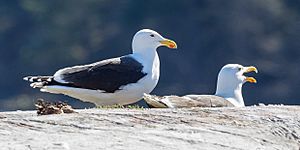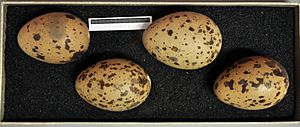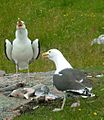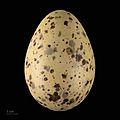Great black-backed gull facts for kids
Quick facts for kids Great black-backed gull |
|
|---|---|
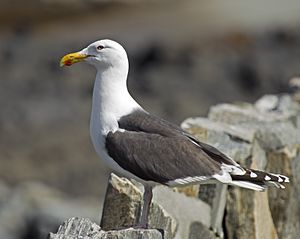 |
|
| Conservation status | |
| Scientific classification | |
| Genus: |
Larus
|
| Species: |
marinus
|
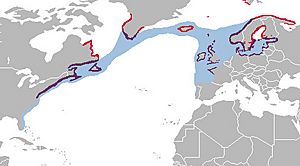 |
|
| Distribution across the Northern Hemisphere. Breeding range Year-round range Wintering range | |
The great black-backed gull (Larus marinus) is the biggest member of the gull family. Some people call it the greater black-backed gull, but that's a mistake. Experts at the Cornell Lab of Ornithology call it "the king of the Atlantic waterfront". This bird is a very strong hunter, a bit of a pirate, and a scavenger.
It lives and raises its young on the coasts and islands of Europe and North America, especially around the North Atlantic. These gulls usually stay in one area. However, some travel south or move inland to large lakes during colder months. Adult great black-backed gulls have a white head, neck, and belly. Their wings and back are dark grey. They have pink legs and a yellow beak.
Contents
About the Great Black-backed Gull
The great black-backed gull is the largest gull in the world. It is much bigger than a herring gull. Only a few other gulls, like Pallas's gull and glaucous gull, come close to its size. This gull is about 64 to 79 centimeters (25 to 31 inches) long. Its wings can spread up to 1.5 to 1.7 meters (5 to 5.5 feet) wide. It weighs between 0.75 and 2.3 kilograms (1.6 to 5.1 pounds). Males are usually heavier than females.
The great black-backed gull looks strong and impressive. It has a large, powerful beak. Its beak is about 5.4 to 7.25 cm (2.1 to 2.9 in) long. Its legs are pinkish. The beak is yellow or yellow-pink with some orange or red near the tip.
How to Identify Them
Adult great black-backed gulls are easy to spot. No other very large gull in the North Atlantic has such dark, blackish wings. Other gulls in this area have lighter grey backs. The great black-backed gull has grayish-black wings and back. It also has bright white "mirrors" on its wing tips.
The lesser black-backed gull is much smaller. It usually weighs about half as much. It also has yellowish legs and a lighter grey or brownish back.
Young Gulls
Young gulls, under one year old, have brownish-black upper parts that look scaly. Their heads and bellies are streaked with gray-brown. Their wing feathers are blackish-brown. The tail of a young gull is white with zigzag patterns and a broken black band near the tip. Their beak is brownish-black with a white tip, and their legs are dark bluish-gray.
As they get older, their colors change. By their third year, they look more like adults, but a bit streakier. It takes them at least four years to become fully grown adults. Their voice is a deep "laughing" cry, kaa-ga-ga. It sounds much deeper than other gulls.
Where They Live and Their Home
You can find these gulls breeding along the coasts of northwestern Russia, Scandinavia, the Baltic Sea, northwestern France, the United Kingdom, and Ireland. Across the northern Atlantic, they live in Iceland, the Faroe Islands, southern Greenland, and along the Atlantic coasts of Canada and the United States.
They used to only visit areas south of Canada in North America during winter. But now, they have started breeding in places like New England and as far south as North Carolina. Gulls from colder areas fly south for winter. They can be found on the northern coasts of Europe, from the Baltic Sea to southern Portugal. In North America, they go down to coastal Florida. Sometimes, they even travel as far south as the Caribbean.
Great black-backed gulls live in many coastal areas. This includes rocky and sandy coasts and estuaries. They also live in inland wet places like lakes, ponds, rivers, wet fields, and moorland. They usually stay close to large bodies of water, even when they go inland. Today, you can often see them at garbage dumps, both near the coast and far inland. They also like to nest on dredge spoils, which are piles of sand and mud from digging.
They usually build nests in places where predators cannot easily reach them. These places include vegetated islands, sand dunes, flat-topped rocks, and even building roofs. In winter, they often fly far out to sea to find food.
What They Eat
Great black-backed gulls eat many different things. They are apex predators, meaning they are at the top of their food chain. They are also very curious. They will check out any small creature they find and eat almost anything they can swallow. A lot of their food comes from scavenging, especially from human garbage. Garbage dumps are a big attraction for these gulls.
Like most gulls, they often catch fish. They will eat any fish smaller than themselves that is near the water's surface. Fish are usually the main food found in their stomachs. They also eat different kinds of squid, crabs, sea urchins, starfish, and other crustaceans and mollusks.
Unlike most other gulls, great black-backed gulls are very good hunters. They often hunt and kill prey smaller than themselves. They act more like a raptor (like an eagle) than a typical gull. They don't have sharp talons or a curved beak like a raptor. Instead, they use their strength and determination to hunt.
When they attack other animals, they often target seabird eggs, chicks, or young birds in their nests. This includes smaller gulls, terns, eiders, and gannets. They have even been seen hunting adult birds like ducks, Manx shearwaters, Atlantic puffins, and rock pigeons. They might chase other birds in the air and jab them with their beak to bring them down. They can kill healthy adult birds weighing up to 750 grams (1.6 pounds). They also eat land animals like rats and even sick lambs.
Most food is swallowed whole. If food is too big, they shake it until it breaks into pieces. Like some other gulls, they will fly into the air with molluscs or eggs and drop them on rocks to crack them open. They also eat berries and insects when they can find them.
These gulls are also skilled at stealing food from other birds. They often take fish or other prey caught by other gulls. They are known to be very dominant. They have even been seen stealing food from a peregrine falcon and fighting a northern goshawk for its kill. Because they use intimidation, some people call them "merciless tyrants." They are also attracted to large marine animals like Atlantic bluefin tuna or humpback whales. They catch fish that these bigger animals push to the surface.
Reproduction and Life Cycle
Great black-backed gulls breed alone or in small groups. Sometimes, they nest within colonies of other gulls. Young adult gulls find a partner in March or April. The next spring, the same pair usually meets again at their old nest. If one bird doesn't show up, the other will look for a new mate.
They build a nest on the ground. It is often on a rocky pile, a fallen log, or something else that can protect the eggs. They usually make a few test nests before choosing the best one. Then, they line it with grass, seaweed, moss, or even things like rope or plastic. If they nest on city roofs, they often reuse old nests.
The female usually lays three eggs between late April and late June. If only two eggs are found, it usually means one egg was destroyed. It takes about one week for the female to lay all three eggs. The parents start sitting on the eggs only after all three are laid. This means all three chicks hatch on the same day. The parents are usually successful in raising all three chicks.
The eggs are greenish-brown with dark spots. Both parents take turns sitting on the eggs for about 28 days. During this time, they try to stay quiet and hidden. The parents are very dedicated. They both take turns sitting on the young, defending the nest, and finding food.
Young great black-backed gulls leave the nest area when they are about 50 days old. They might stay with their parents for about six months. However, most young gulls join other young gulls to find food by the fall. These gulls are ready to breed when they get their adult feathers at four years old. But they might not successfully breed until they are six years old.
How Long They Live and What Harms Them
These birds live for a relatively long time. The oldest wild great black-backed gull ever recorded lived for 27.1 years. They are rarely kept in zoos. However, other large gulls have been known to live for over 44 years. Generally, bigger birds tend to live longer than smaller ones.
Most gulls die when they are young. Bad weather, like floods, and not enough food can harm them. Predators also hunt chicks and eggs. These predators include crows, cats, other gulls, raccoons, and rats.
Only a few birds are known to regularly hunt healthy, fully grown great black-backed gulls. These include the bald eagle, white-tailed eagle, and golden eagle. In some places, great black-backed gulls are a common food source for white-tailed eagles. Gulls often try to scare away these large eagles. Killer whales and sharks also eat adult and young gulls at sea. In some areas where large eagles are not present, the great black-backed gull is considered the top predator.
Current Status
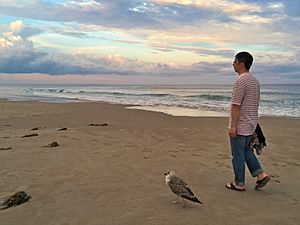
In the past, people hunted great black-backed gulls for their feathers. These feathers were used to make hats. Because of this, the gulls disappeared from many parts of their home range. However, today, they have learned to live near humans. They even use city roofs as nesting sites. This has caused their numbers to grow quickly.
Now, the great black-backed gull is a common bird in its range. In some areas, their numbers have grown so much that people see them as a problem. This is especially true near airports, where they can cause plane collisions. Also, in some coastal areas, they sometimes compete with or hunt rarer seabirds, like Atlantic puffins. This might lead to conservation groups getting involved. The increase in great black-backed gulls is linked to more fishing activities in the North Sea during winter.
There are no major threats to the great black-backed gull right now. However, high levels of toxic pollution are often found in these birds and their eggs. This happens when they eat contaminated prey. This pollution can reduce how many young they successfully raise. Also, human activity can disturb their breeding. This can cause them to leave their eggs, making the eggs vulnerable to weather and predators.
Images for kids
-
Larus marinus and Larus argentatus together, Øresund
-
Juvenile, Cape May Point, New Jersey
-
Juvenile, Trassenheide, Germany
See also
 In Spanish: Gavión atlántico para niños
In Spanish: Gavión atlántico para niños





